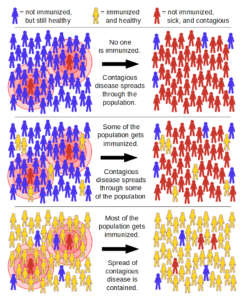
Click for larger version. © 2017 Tkarcher, CC BY-SA 4.0, via Wikimedia Commons
… daily vaccination rates are slipping, and there is widespread consensus among scientists and public health experts that the herd immunity threshold is not attainable — at least not in the foreseeable future, and perhaps not ever.
Instead, they are coming to the conclusion that rather than making a long-promised exit, the virus will most likely become a manageable threat that will continue to circulate in the United States for years to come, still causing hospitalizations and deaths but in much smaller numbers.
How much smaller is uncertain and depends in part on how much of the nation, and the world, becomes vaccinated and how the coronavirus evolves. It is already clear, however, that the virus is changing too quickly, new variants are spreading too easily and vaccination is proceeding too slowly for herd immunity to be within reach anytime soon.
The problem is a combination of vaccine hesitancy and COVID mutation:
The predominant variant now circulating in the United States, called B.1.1.7 and first identified in Britain, is about 60 percent more transmissible.
As a result, experts now calculate the herd immunity threshold to be at least 80 percent. If even more contagious variants develop, or if scientists find that immunized people can still transmit the virus, the calculation will have to be revised upward again.
Plus, it’s a global problem: even if we have a high vaccination rate here, new localized mini-waves of infection can be set off by people visiting from, or returning form, abroad, especially if vaccination rates are lower there.
In time, the best we may be able to hope for is making COVID a seasonal problem like the influenza. Probably with another annual shot or two.
Naturally, vaccination skeptics will respond “why bother?” which is totally the wrong reaction…the more people are vaccinated, the less spread there will be. Not to mention the better the chances of the person actually surviving an infection.
